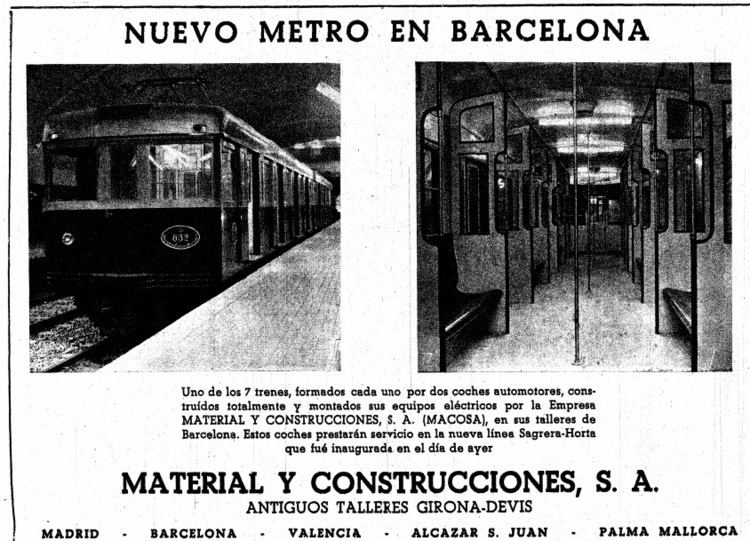Industry Railway Founded 1947 | Headquarters Spain | |
 | ||
Genre Heavy engineering, metal, transportation Fate Absorbed into Alstom, then Vossloh, then Stadler Predecessor Construcciones Devis
and
Sociedad Material para Ferrocarriles y Construcciones S.A. Successor 1989: Mediterranea de Industrias del Ferrocarril, S.A. (Meinfesa)
2005: Vossloh España Defunct 2005 (acquired by "Vossloh España") | ||
Material y Construcciones S.A. or MACOSA was a Spanish heavy-engineering company, mainly producing products for the railway industry. From 1989 onwards the organisation was named Meinfesa and became part of the GEC-Alstom group of companies, until 2005 when it became part of the Vossloh group as Vosloh España, later renamed Vossloh Rail Vehicles. The plant was sold to Stadler in 2015.
Contents
- Eminem outsidaz ft eminem macosa best quality on youtube
- MACOSA
- Meinfesa
- Vossloh Espaa
- Notable products
- References
Eminem outsidaz ft eminem macosa best quality on youtube
MACOSA
The Company Material y Construcciones S.A. (or MACOSA) was founded in 1947 by the merger of the Valencian company Construcciones Devis (founded by Talleres Devis in 1879) and the Sociedad Material para Ferrocarriles y Construcciones S.A. of Barcelona; this coincided with the beginning of the industrialisation of Spain.
Initially the organisation was not entirely rail orientated, producing buses, trolleys and other road based transportation systems. In the years following its formation the company expanded, with the Valencia plant gaining a 50,000m2 extension becoming one of the major producers of rolling stock in Spain. By 1952 the new company had produced 48 Type 2400 locomotives as well as two for Portugal.
The only narrow gauge locomotives constructed by MACOSA was the type 130 for the railroad of Ponferrada to Villablino in 1951 and 1956 (PV numbers 13 to 16), which were based on a type made in 1914 by Krauss-Maffeu for the Basque Railroads. (See Engerth locomotive for more information)
In the 1950s the larger Barcelona plant concentrated on casting and forming steel as well as repair of cars, buses, coaches etc. The Valencia plant produced steam boilers, as well as constructing and repairing steam and electric locomotives and other rolling stock. The valencia plant also produced other heavy engineering products such as cranes, metal parts for dams. There was also a smaller factory at Alcázar de San Juan producing and maintaining wagons.
MACOSA made the last steam locomotive for RENFE, a 2-8-2 'Mikado' with locomotive number 141-2328 produced in 1958.
Another expansion coincided with the countries' 'stabilisation plan' of 1959, and thus the company formed part of the rapid economic growth of Spain in the 1960s, triggered by the industrialised economy reaching critical mass. (See Spanish economic miracle)
During the 1960s locomotives were produced under license from General Motors, at first practically the entire locomotive was of GM design, later the company produced much of the locomotives to its own design, but still using a GM (later Electro-Motive Diesel) engine and transmission system. This arrangement continued well into the 2000s, with successor companies still manufacturing diesel electric locomotives in Valencia with GM engines and transmission systems.
In 1970, MACOSA was the second company of the rail vehicle sector in Spain, after Construcciones y Auxiliar de Ferrocarriles.
During its long history over a thousand locomotives were produced: first steam, then electric and diesel-electric as well as shunting locomotives. In addition countless other rail vehicles were produced: trams, metros, diesel and electric units and freight wagons as well as thousands of bogies, some for Spain, others for destinations around the world.
Meinfesa
In 1989 the company became Mediterranea de Industrias del Ferrocarril, S.A. (or Meinfesa) and became part of the GEC-Alstom multinational in 1991, after this the company moved locomotive production to a new plant at Albuixech (Valencia).
After the move the huge original factory was to be demolished, and despite attempts to save it due to its historical significance to the country of Spain (as well as due to architecture of the 1920s built central core - with huge nave like sheds in design), like many other derelict industrial sites around the world, progress could not be stopped, and in a final twist of fate, its destruction made space for the AVE high speed train to run through.
Shortly thereafter (1990-2), a big order from Renfe was received for the sub-types 319.2, 319.3 and 319.4; under GEC-Alstom's ownership GM-EMD engined diesel locomotives were also produced at the plant for export to the UK and Israel.
Additionally 60 General Motors type GM-8B Class 310 for RENFE between 1989 and 1991, and the GA-DE 900 AS diesel electric shunting locomotive (based on the RENFE Class 311) was produced during the 1990s for the state railways of Switzerland (SBB Am 841), the railways of Mexico, Israel state railways (IR), and for the Egyptian National Railways.
Vossloh España
In March 2005 ownership changed again, this time to Vossloh AG, and the organisation was renamed Vossloh España, as part of the Vossloh group.
In the first five years of Vossloh ownership the GA 1000 AS shunter was built for SNCF, as well as rebuilding of the RENFE Class 333 and construction of the RENFE Class 334 and, later, the production of EMD powered Vossloh Euro locomotives. The 1,000 mm (3 ft 3 3⁄8 in) gauge 15 kV DC electric passenger metro trains Serie 4300 were also produced in this period for Ferrocarrils de la Generalitat Valenciana.
The rail-vehicles division was announced as sold to Stadler Rail in late 2015, for €48 million.
